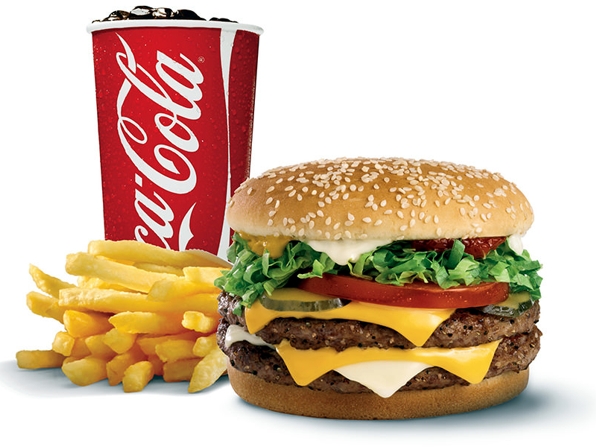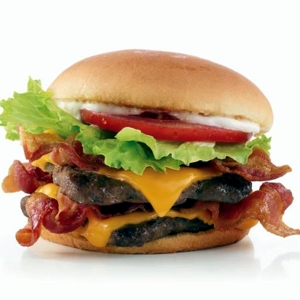The major Fast Food chains have spent a lot of time and money over the past few years promoting their new ‘healthier’ offerings. But a long-term survey of core menu items at the top 10 Fast Food chains shows their fare is probably less healthy now than it was 30 years ago…
 A typical Burger-and-Fries meal: Delicious, Juicy, Salty, enticing…
A typical Burger-and-Fries meal: Delicious, Juicy, Salty, enticing…
But how about making that a Diet Drink and Small Fries and
a single-Patty Burger? Chances are, you’ll live longer.
Lab analysis of menu items from the 10 most popular Fast Food chains, in 1986, 1991 and 2016, reveals that the ‘Burgers and Fries’ sector has been making changes in its products that render them less healthy than they used to be. This in the face of major campaigns to promote new ‘healthier’ menu options, designed to appeal to younger, more heath-conscious diners.
No rocket science required…
Dr. Megan A. McCrory of the Department of Health Sciences at Boston University’s Sargent College is the lead author of the survey report, and team leader on the comparison study. A digest of the survey describes their methodology thus:
Dr. McCrory and colleagues examined changes over the 30-year period from 1986 to 2016 in energy, portion size, energy density, sodium, iron, and calcium of menu items in entrees, sides, and desserts categories offered by 10 of the top fast-food restaurants (according to sales). Data were collected using The Fast Food Guide, published in 1986 and 1991, and online sources in 2016.
Pretty simple. And with very little room for error.
What they found…
The survey revealed significant changes in potion size and nutrient content in Fast Food menu items over the past 30 years:
- Total number of entrées, desserts and side dishes increased by 226 percent, or 22.9 items per year.
- Calories in all three categories increased significantly, with the largest increases in desserts (62 kcals per decade), followed by entrees (30 kcals per decade). These increases were mainly due to the increase in portion size, which was statistically significant in entrees (13 grams per decade) and desserts (24 grams per decade) categories.
- Sodium content also increased significantly in all menu categories.
- At four of the 10 restaurants studied, information on calcium and iron content was available. Calcium increased significantly in entrées and desserts, while iron levels increased significantly in desserts.
Alone among the survey findings, the Calcium and Iron content increases struck positive notes.
The takeaway…
Fast-food restaurants are on the rise around the world. In the US, about 37 percent of adults (aged 20 and over) consume fast foods on any given day and that increases to 45 percent for adults aged 20-39. One meal with an entrée and side provides an average of 767 Calories, close to 40 percent of a 2,000-calorie a day diet. Add a caloric beverage and the amount increases to 45-50 percent of a person’s daily Calorie requirement.
“Given the popularity of fast food, our study highlights one of the changes in our food environment that is likely part of the reason for the increase in obesity and related chronic conditions over the past several decades, which are now among the main causes of death in the US,” McCrory concludes.
My take…
I’ve said it before and I’ll say at again here – because McCrory does in her report: it’s time to encourage folks to eat less Fast Food, or at least choose smaller portions. And I’ll gladly point out (again) that Fast Food menus are uniquely positioned to help folks make healthier choices, simply because they offer multiple sizes of Burgers, Fries and Drinks. But no Fast Food counter clerk is going to suggest an overweight customer order smaller portions. If the boss found out, they’d probably be put on permanent cleanup duty, because the Fast Food business is all about volume and profits. As I’ve said before, it’s up to us to make healthier use of the Fast Food option in our overall diets. Because the chains aren’t going to do anything along those lines themselves.
~ Maggie J.

